Found a total of 10000 related content
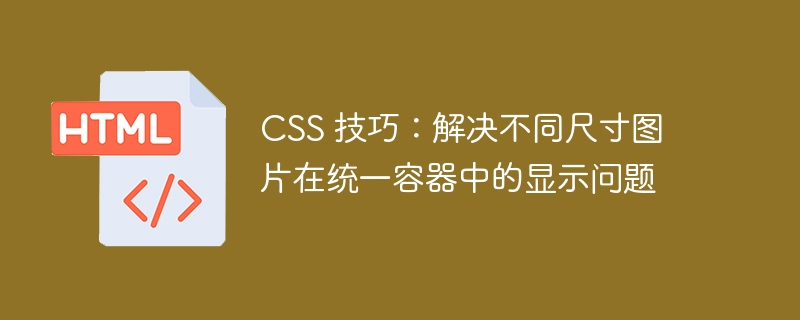
CSS tips: Solve the problem of displaying images in a unified container with different sizes
Article Introduction:This article aims to solve the problem of how to ensure that these images are displayed correctly in a unified container in CSS when using fixed-size images containing contents of different sizes (such as icons). We will explore using different values of the object-fit attribute to control how the image adapts to its container, so as to achieve the desired visual effect and avoid the problem of image deformation or different sizes.
2025-08-15
comment 0
497

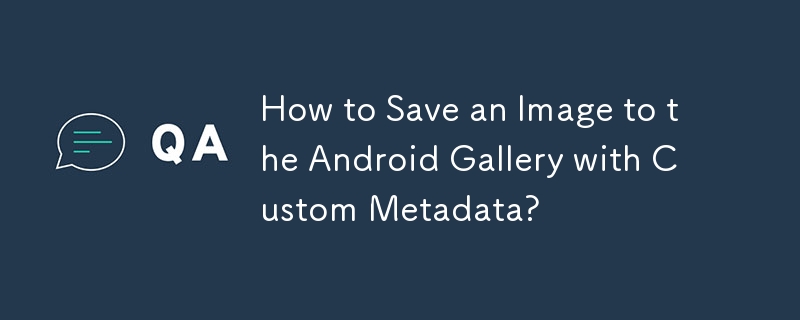

How to use the srcset attribute for responsive images in HTML
Article Introduction:By providing image files of different resolutions or sizes, the srcset attribute enables the browser to select the most appropriate image based on the device's screen size, pixel density and network conditions, thereby improving page loading speed and visual quality. 1. When using the width descriptor (w), images of different widths need to be listed in the srcset (such as 480w, 800w), and the display width of the image at different breakpoints should be defined with the sizes attribute, so that the browser can select the best image based on this; 2. When using the pixel density descriptor (x), corresponding images can be provided for standard screens (1x), Retina screens (2x), etc., suitable for scenes where only pixel density needs to be adapted; 3. Combining srcset and sizes can achieve fully responsive images, and self-responsive images can be achieved in different layouts.
2025-08-02
comment 0
879

How to set the bootstrap button
Article Introduction:You can customize buttons in Bootstrap by: 1. Use different classes to change button styles; 2. Use classes to change button sizes; 3. Use .disabled class to disable buttons; 4. Add icons to buttons; 5. Use .btn-{color} class to set button colors.
2025-04-07
comment 0
817
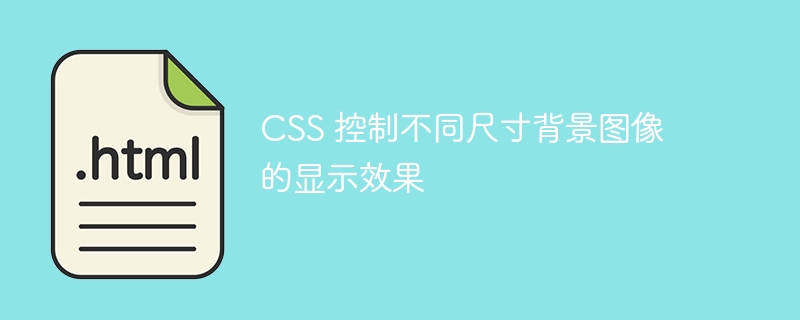
CSS controls the display effect of background images of different sizes
Article Introduction:This article aims to solve the problem of inconsistent display of PNG icons of different sizes using CSS, because the icon itself contains a transparent background. We will explore how to use the object-fit attribute to flexibly control the scaling and cropping of images in the container, so as to ensure that all icons can be presented at the desired size, solving the problem of different icon display sizes.
2025-08-15
comment 0
652

Image size adaptation in YOLOv8 reasoning: Principles and Practice
Article Introduction:Deep learning models such as YOLOv8 have strict requirements on the size of the input image when inference. The fixed matrix structure inside the model determines that it can only process images of specific sizes. When the model makes inference on images of different sizes than when it was trained, without proper image preprocessing (such as size adjustment), it will result in prediction failure or performance drop sharply. This article will elaborate on its reasons and provide image size adjustment solutions based on PyTorch and TensorFlow to ensure the correct reasoning of the model on images of different sizes.
2025-08-04
comment 0
273
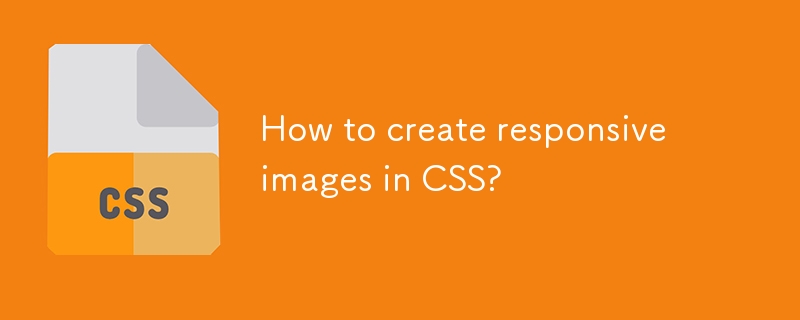
How to create responsive images in CSS?
Article Introduction:The core of the implementation of responsive images is to use HTML's srcset and sizes attributes to match CSS styles. 1. Use srcset to specify multiple pictures of different sizes and mark their widths (such as 480w, 800w, 1200w), so that the browser can automatically select the most suitable picture according to the viewport width; 2. Define the display ratio of the picture under different screen sizes through sizes, for example, "(max-width:600px)100vw" means that the small screen occupies the full viewport, otherwise it will occupy half of the width; 3. Set img{max-width:100%;height:auto;} in CSS to ensure that the picture is adaptable to the container and maintain the proportion; 4. Optionally, in srcset
2025-06-28
comment 0
739

Implementing Responsive Images with HTML
Article Introduction:The key to responsive pictures is to load the appropriate size as needed, which is mainly achieved in three ways: First, use tags to set max-width and height attributes with CSS to achieve basic responsiveness; second, use srcset and sizes attributes to select pictures of different sizes according to the device; third, use elements to achieve more refined control, including format and content switching. These three methods are suitable for scenes of different complexity, ensuring that images can be displayed efficiently on various devices.
2025-07-24
comment 0
801

How to use the srcset and sizes attributes for responsive images?
Article Introduction:srcset and sizes are key properties used in HTML for responsive images. 1.srcset provides multiple image versions for the browser to choose, such as pictures of different widths or pixel density; 2.sizes tells the browser the display width of the picture under different screen conditions, helping the browser to select the most suitable image resource based on the viewport size and device pixel ratio; 3. When using it, you should prepare multiple sizes of pictures, clearly named, test device behavior, pay attention to performance trade-offs, and retain fallback's src pictures to ensure compatibility and default display effect.
2025-07-09
comment 0
482

What is the srcset attribute for responsive images in HTML5?
Article Introduction:The srcset attribute is used to provide multiple image sources based on the device's screen resolution and capabilities, allowing the browser to select the most suitable image. 1. It specifies different versions of images through width descriptor (w) and pixel density descriptor (x); 2. Combined with the sizes attribute, the browser selects images based on the viewport width and device pixel ratio; 3. Using srcset can improve performance, save bandwidth and ensure high-resolution display effect; 4. Combined with elements, it can achieve more refined responsive image control. Therefore, srcset can intelligently provide the best image for different devices, avoiding the "one-size-fits-all" problem.
2025-09-03
comment 0
313

How do I use CSS sprites to reduce the number of HTTP requests?
Article Introduction:CSS wizard is a technique that optimizes web page performance, reducing HTTP requests by combining multiple small images into one file and locating the required parts with CSS background. 1. Create a sprite image: Use tools to combine multiple images into a large image; 2. Use CSS to set the background image and position, and display specific areas with fixed sizes; 3. Use corresponding class names to display different icons in HTML. It is suitable for frequently used icons or buttons, especially in old browsers or scenarios that require extreme optimization. However, manual coordinate maintenance is cumbersome, and efficiency can be improved with the help of automation tools.
2025-06-20
comment 0
549

The ultimate guide to vertically centering and aligning pictures in Bootstrap columns
Article Introduction:This article aims to solve the problem of how to align text content vertically with respect to its adjacent pictures in Bootstrap raster systems. By leveraging Bootstrap's Flexbox functionality, you can achieve perfect vertical alignment of text and pictures under different screen sizes by simply adding a class, avoiding misalignment problems caused by changes in screen size.
2025-08-17
comment 0
789
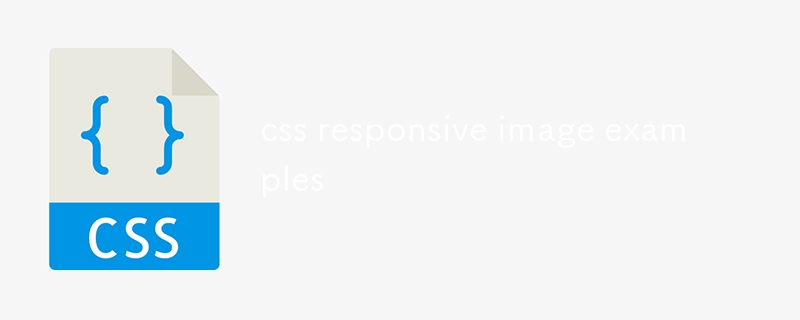
css responsive image examples
Article Introduction:Responsive pictures can be implemented in five ways: 1. Use max-width:100% and height:auto to ensure that the picture is scaled in the container and maintains the aspect ratio; 2. Use object-fit to control the image filling method, cover crop filling and contain complete display; 3. Use srcset and sizes attributes to load the appropriate pictures according to the device to improve performance; 4. Use background-size:cover to realize the responsiveness of decorative background images; 5. Use Flexbox or Grid layout to create a responsive picture grid, which automatically adapts to different screen sizes. Each method is suitable for different scenarios and needs to be paid attention to details such as height:auto to prevent deformation.
2025-07-25
comment 0
415
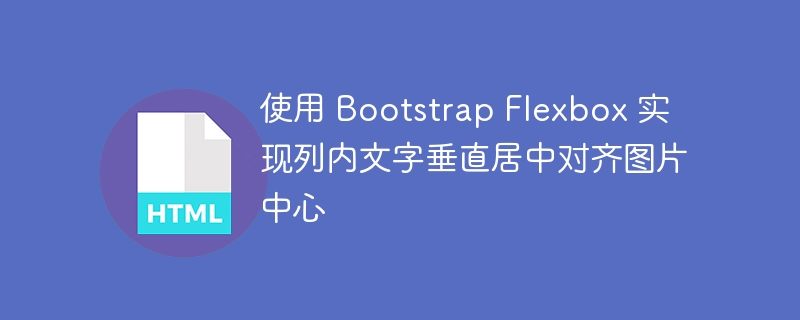
Use Bootstrap Flexbox to achieve vertical centering of text in columns
Article Introduction:This article aims to explain how to use Bootstrap's Flexbox function to achieve vertical centering of text in a column to the center point of the same row of pictures. By adding simple class names, you can easily achieve vertical centering of text under responsive layout, solving the problem of text position offset under different screen sizes.
2025-08-17
comment 0
950

Can you use clearfix for Bootstrap pictures centered?
Article Introduction:Use Bootstrap to center the image without clearfix. Bootstrap provides a variety of methods to align pictures. The most common method is to use the mx-auto class name, which uses the margin attribute of CSS to automatically set the margin in the horizontal direction to auto to achieve the centering effect. In addition, the img-fluid class can adapt the image width to the parent element width, ensuring that the image can also maintain the best display effect under different screen sizes.
2025-04-07
comment 0
543

How to load locally saved Docker image files
Article Introduction:The reason for loading local Docker images is to use images when there is no network connection and to flexibly migrate images between different environments to ensure consistent development and deployment. Specific operations include: 1. Use the dockersave command to save the image as a .tar file; 2. Use the dockerload command to load the image in the .tar file; 3. Pay attention to ensuring the integrity of the .tar file, use the pv command to monitor the loading progress of large images, and consider using DockerRegistry as an intermediary to transmit the image.
2025-05-19
comment 0
1087
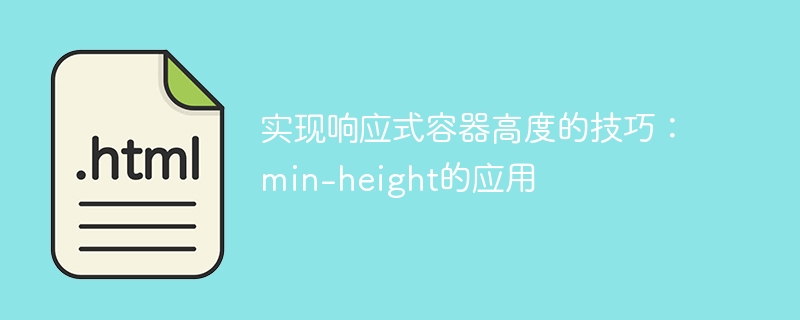
Tips for realizing the height of responsive containers: Application of min-height
Article Introduction:This article explores how to set a default (or minimum) height for a container in CSS while ensuring it is responsive at different screen sizes. By introducing the min-height property, developers can effectively balance the high demands in design with the adaptability of layout, especially when processing containers containing object-fit:cover images, ensuring content filling and layout stability.
2025-09-02
comment 0
466
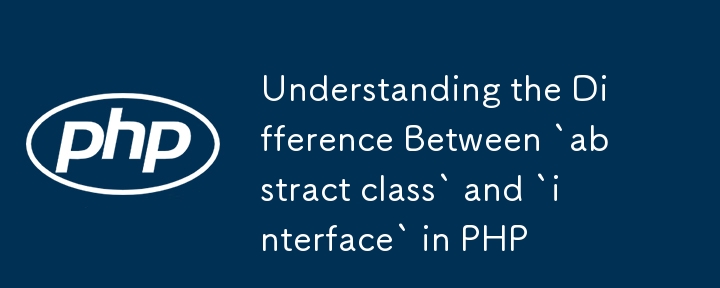

How to use the picture element for responsive images?
Article Introduction:Using elements allows better handling of responsive images, which enables the loading of the most appropriate images based on screen size, resolution and format through multiple and one implementation. Specifically, it includes: 1. Different cropped images under different screen sizes; 2. Supports modern formats such as WebP or AVIF; 3. High-definition pictures of high-resolution devices. Structurally, you need to use the definition conditions and image sources in turn, and use them as fallback schemes. At the same time, you should always include, use srcset instead of src, and specify the format through type to ensure compatibility. In addition, breakpoints should be set reasonably, pictures should be optimized, and valid alt text should be retained. In simple scenarios, only imgsrcset can be used to implement responsiveness.
2025-07-13
comment 0
717



















